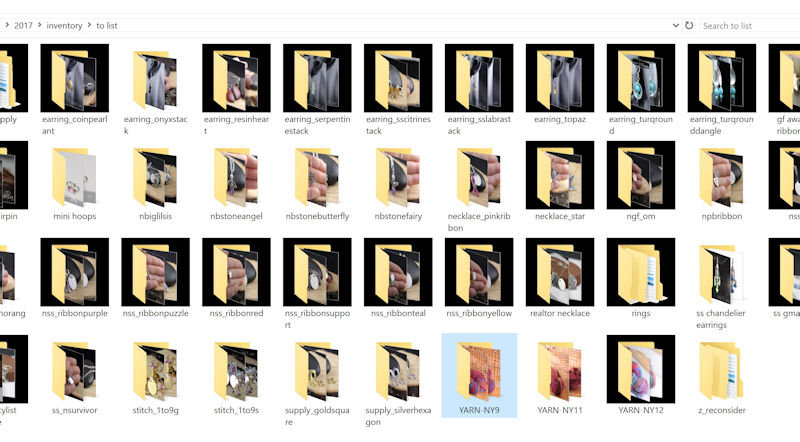

Here’s a behind-the-scenes look at selling handmade online: this is a screenshot of the many products that I have made and yet to list. Some of these items have been around for over a year. The problem is this: I love to make things and I would spend my entire lifetime doing just that. Taking the time to get items ready for sale and listed, not so much. I wish it were as simple as: I make something, I take a picture of it, and magically customers come along and buy it. Not so. When you are an artist/maker of any kind – in charge of selling your work – you wear many hats/learn many talents to make that sale. We don’t have a MLM company to back us with promotional kits on the ready to help promote our goods. I’ve considered hiring outside help but any kind of PR I’ve researched was too out of reach for me cost wise. When you think about the price that we have to charge to be competitive with the mass-produced, selling handmade online is a losing battle.
Let’s look at the anatomy of a (handmade) listing, shall we?
Conceptualizing and designing the idea
Although my items have evolved into simple keepsake designs over the years, there is still more to it than pairing charms on a necklace. Everything I make is something I would wear. When I am inspired by a theme I then have to choose: will it be sterling silver or gold-filled or both? What size engraving blank should I pair with the charm? What font should I use? I have to then engrave the prototypes, and assemble a sample so that I can assess wearability and aesthetics. Do the charms look good together? Do they hang well together? Is there movement/flow? Should I add a bead? Or add/remove another element?
This is another reason why I normally turn down custom orders these days. Not the personalization I offer, but built-from-scratch requests. All the time that is put into conceptualizing the design would be out of reach price wise for the customer. Add to it that the majority of the time changes or tweaks are asked for, or interest is lost entirely and the piece is never purchased. For these reasons custom orders are simply not worth the time involved for me. Before I had kids I was more willing to donate my time for custom work, but these days time is a precious commodity. Of the requests that I do take, it is because I already have something in mind that has not yet left the design notebook. In this instance if the potential customer changes their mind I can still sell it as a new product. Bottom line is I have to be mindful of the time taken to develop a custom piece and the compensation involved, all the while staying true to my aesthetic and personal style. And goodness no – I will not copy someone else’s work…

Photographing the new design
I wish I was talented enough to get a few good shots of my products in just a few minutes, but the truth is, it takes quite a bit of time and patience to get a good shot. I have to set up the camera on the tripod, after I put on the macro lens. Then turn on/position the lighting. It has a dedicated spot in the studio but it always gets knocked out-of-place between cats and kids. Plus natural light will determine which direction the lights will be. Placing the item within the lighting so that it stays at the right position is also tricky. It is very tedious to set up a piece of jewelry and have it stay in place without falling over in an unattractive position. Sometimes I can use a bit of sticky tack to help keep charms in place. But for the most part, I like a natural drape over an object such as a smooth stone. Once I get the item positioned, I have to carefully move it ever so slightly left and right to get the lighting angle in the “sweet” spot: not so much light that it drowns out the engraving, and not so little that it appears dark which is also hard to see. When I find the sweet spot I will snap several pictures. I do have the added bonus of computer software so I can sharpen focus directly onto the computer before taking the pictures. Once I get several shots in one position I will try at least one more, plus a hand shot for scale. The hand shot turns me into a contortion artist while I get my hand in frame, focus the shot via computer with other hand, then hold still enough to take the picture. I would say the photography aspect is my least favorite thing to do. I procrastinate on it a lot. Like, until the “take photos of these new items” bin is over-flowing. Part of the reason is that photography is the most frustrating. You can take a ton of shots only to discard every single one when reviewed later. I have logged hundreds of hours over the years with different cameras, tried all kinds of set up and contraptions and watched many videos/read many blogs and I still think my pictures are acceptable for selling on the internet, but they aren’t stellar. I did purchase a short online course many years ago that I found the most helpful. But what works for me is based on putting in the time. There is no shortcut.
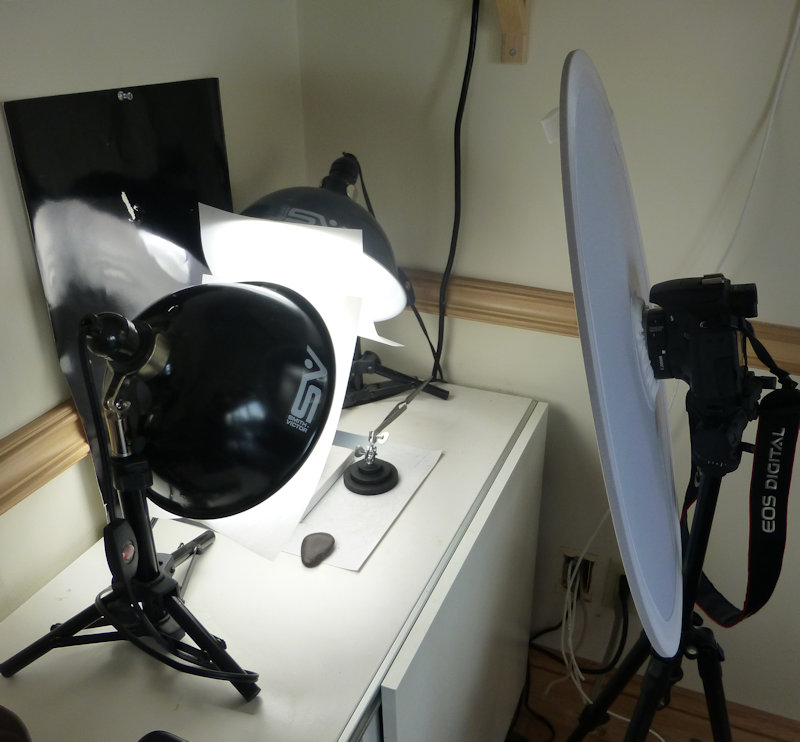
Editing pictures
Photo editing can take even more time than taking the pictures. I don’t do any color correcting – just some brightening if the photo is too dark and cropping the photo square. The goal is to have a crisp and clear photo. Different resolutions on devices will have the items looking slightly different color and tone wise anyway. I don’t want to misrepresent what I am selling so I do very little touching up. I’m told my items look even better in person – and that always makes me feel really good. The pictures are attractive enough to make the sale and people are happy with their purchase, rather than disappointed. That is a good thing!
As time-consuming as editing is, I enjoy the process. Seeing my work on-screen is where it comes alive for the potential customer. I love choosing the final images and it is only discouraging when none of the images turned out to be viable for the web (it means I have to repeat the picture-taking step – WAH!).
Finally, I do watermark my photos with my website for copyright and recognition purposes. I know this is sometimes frowned upon for many different reasons: like it’s distracting, or Etsy doesn’t feature watermarked images…however I have witnessed photos being stolen and misrepresented as others’ work by scam artists over the years. Plus photos often get shared on different social network platforms without context as to where it came from.
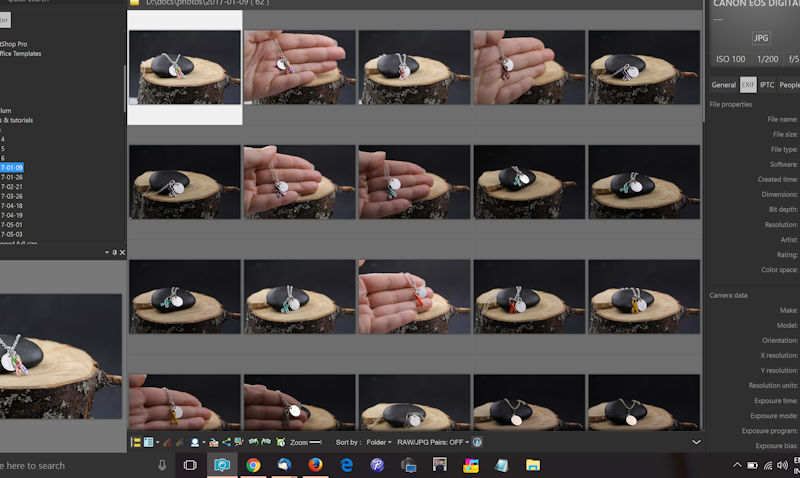
Pricing
Another daunting task that I don’t enjoy is pricing my work. In the beginning I would eye ball the piece and price it from the top of my head – which meant that I was rapidly losing money: not covering even my expenses to make the piece. So I soon moved to spreadsheets to price my work. I have a master spreadsheet with the cost of supplies: I price out to every last jump ring and component. Then I have spreadsheets for the items themselves: one for the keepsakes, and one for yarn as they are very different in pricing structure. This is where I add my costs for my time, packaging, and listing fees. The sad truth is I don’t make very much an hour. I honestly don’t mark up my work very much – and for this reason it’s hard for me to have sales or discounts. When I do run a sale, I am losing money at least on my time. I end up writing sales off as advertising (as well as giveaways).
So why don’t I mark my items up more? The market is solely dictated on the buyers and I have to go with what people are willing to pay. I’ve tried pricing my goods higher and they simply don’t move. Plus I’ve always had the philosophy that everyone deserves to own something nice and well made. I get it, money isn’t always there for the extras. I want my work to be accessible to as many people as possible as it is an expression of me from the heart. The many positive comments I have had over the years is a feeling that money could never buy. Yes I have expenses and bills like anyone else. But I do feel the handmade movement is far bigger than that. Sure I’d love to make more money at what I do, but I’d also like the cost of living to go down for everyone, too…
It never ceases to amaze me the misconception of how expensive handmade goods are or that they are not as good as the mass-produced products that have flashy ads or brand names to go along with them. Oh and if you are getting a lot of free stuff along with your purchase – or for signing others up – don’t think for one second you haven’t paid for it several times over in the markup.
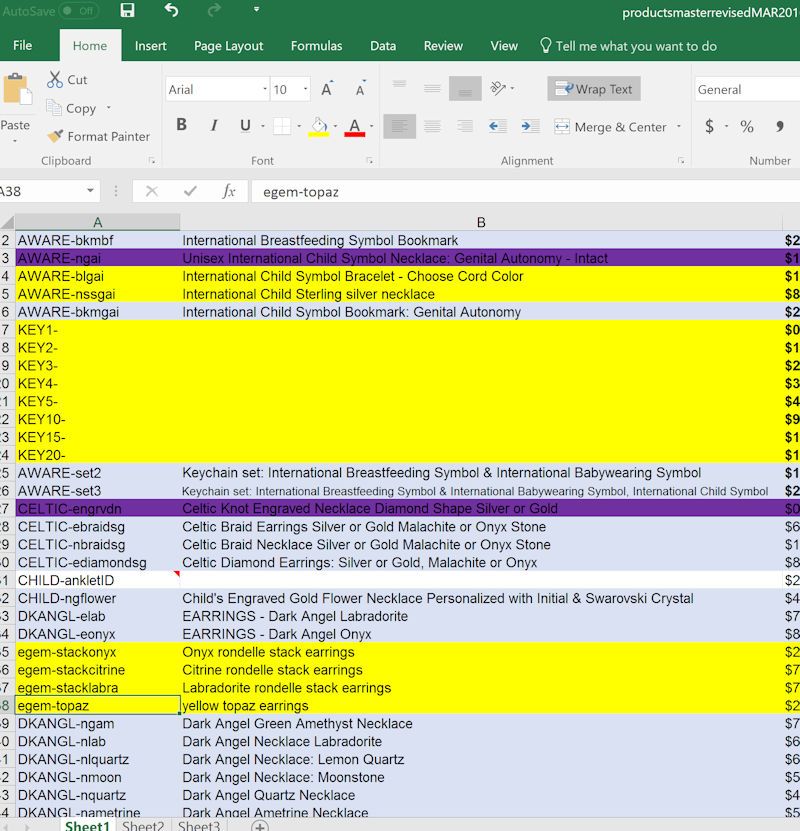
Listing items online
I currently list items on two places online: my personal website and Etsy. I’ve sold on other platforms before but it’s too time consuming for the handful of sales, so I’ve stuck to the two places that I get the most bang for my buck.
I’m quite fortunate to have a software engineer for a husband as well as being a tad geeky myself so a lot of things I can take care of on my own on the front end and all the technical stuff hubby can deal with on the backend. For sellers who constantly complain about Etsy: please stop. Listen, I am not always happy with everything they do over there nor do I agree with every decision that has been made in the evolution of this company. However, once you try to maintain your own website – you come to appreciate that you just have to pay the fees every month and the technical issues are someone’s else’s problem.
Listing items online means writing a decent copy description of the item, making sure it is placed under the right category on your website, uploading the pictures, setting the shipping costs, and doing SEO for each individual item. Nevermind the hours of setup it took beforehand to have a working site – and we use out-of-the-box software to power my website. I am fortunate enough to host my own site thanks to my partner’s business…sort of. By that I mean, don’t forget I have to babysit the site daily to make sure it doesn’t go down due to hosting issues, getting hacked, or the myriad of other issues that can happen that render it useless: like your payment gateway failing or a file corrupting. As for SEO, I admit that I find SEO tedious and it falls to the wayside a lot – and I instead rely on Social Networking for promoting my items and getting them out there. Once again, I appreciate paying Etsy to do my advertising for me. I have a very small budget to promote my listings but there is always a return for doing so.
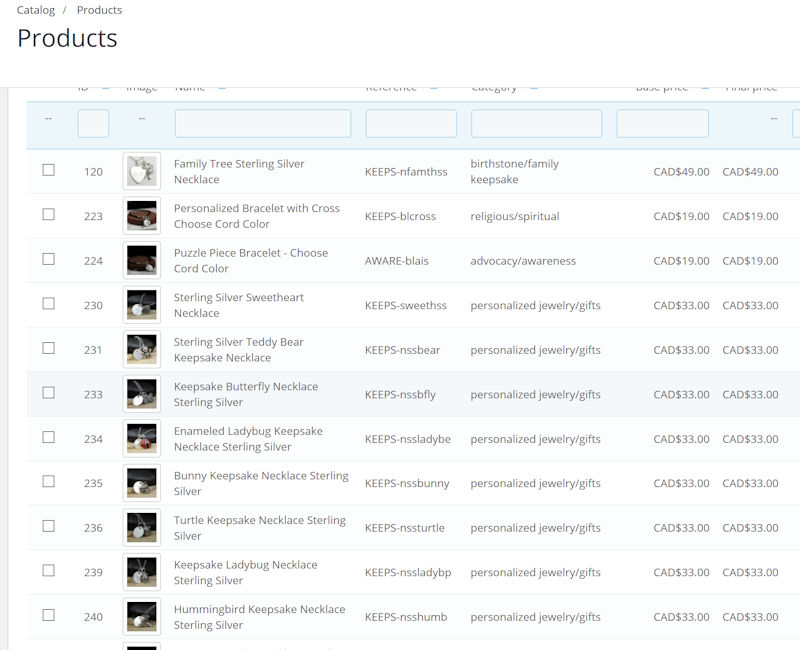
Promoting items
Touching a bit of this in the previous section – promotion is a full-time job in and of itself, something that I just don’t have the stomach for – I admit it. The online pond is very big and you have to scream really loud to get noticed: I’m not so good at selling what I’m selling. I don’t mind sharing and showing what I make, but doing so over and over feels egotistical to me. I am not doing anything life saving here; it’s pretty things. It’s fun yarn and accessories for knitting. None of which is necessary to survive. I also rarely discuss what I do with my friends and family because I don’t want them to feel obligated to support my work. I get it, it’s not to everyone’s taste. I don’t want people to feel like I look at them with dollar signs in my eyes. It is such a good feeling however, to tap into that crowd that loves and gets what I do. Etsy has been wonderful for that. And I appreciate all the good feedback I’ve gotten over the years there. If I ever doubt my talent or abilities, I can read that feedback and know I make good things and provide a positive experience to others.
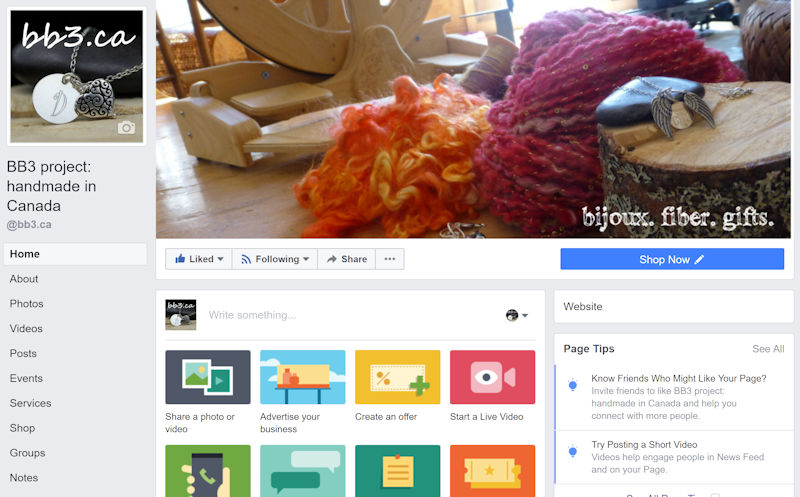
Keeping items fresh & relevant
I used to make beaded jewelry – and I still do, I just find the simple wearable keepsakes translate as “in style” for a longer period of time. The time it takes to design and make beaded jewelry, plus the uniqueness of the designs means more effort to move the finished product. I like to stick with daily wearable pieces, like my ” wings” necklace that I wear everyday.
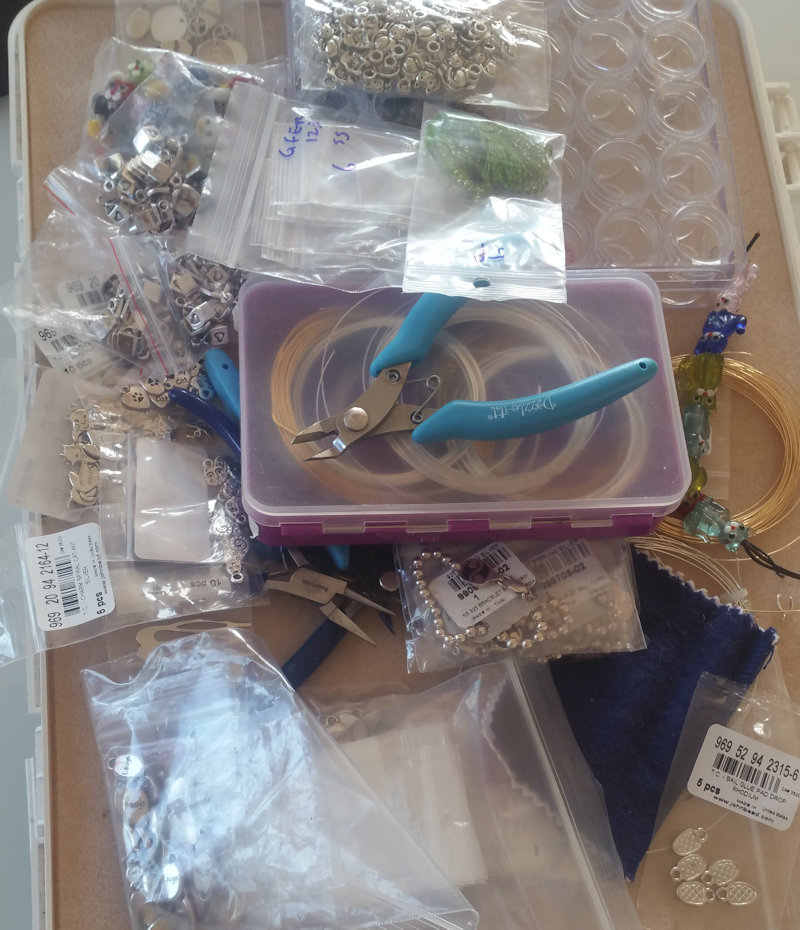
So if it is so hard why do it then?
It’s a drive to keep going that I can’t really explain. A passion for handmade and what I create. Wanting to get my items part of people’s online shopping experience: offering them an alternative to the norm. I do it because it makes my customers feel good, and therefore it makes me feel good. It’s my pay-it-forward. But mainly I do it because I have a drive to create like nobody’s business. It truly does keep me alive and sane, and if I want to keep creating, I have to move the things as they pile up. 🙂
I recognize that when I get resentful or feel stuck & anxious about it, it’s when all my time is spent online rather than making the things I love to make. The ideas run wild in my head and there is no outlet to get them out because I feel I must be responsible and do my social networking today, or list new items today. Once an item sells, most of the time I have to make the item with the customer’s personalization, then package and ship it. So if all my time is in doing just that and no new ideas are flowing, I feel stuck really fast.
I’ve just come to realize it’s about creating balance and even after 16 years at this, I haven’t struck the right chord. I tend to go from one extreme to the next. Now that I have made that revelation, I hopefully will find some motivation to list. Because there are some goodies in this folder that I’d love to get into people’s hands. It makes me happy that I get to share my talents with others.
If you stuck it out and read all this (thank you!) I hope you gain some insight on the behind-the-scenes of the handmade goods you buy online. If you sell or are looking to sell your handmade wares know I feel your pain, and I am here to support, if ever you need…


